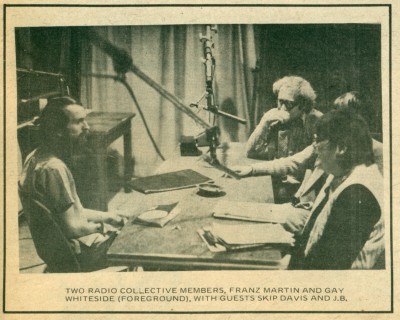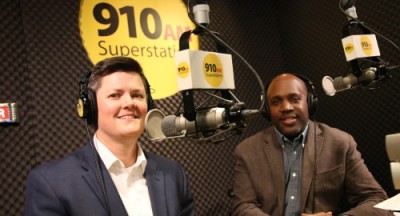When I was 21 and living in a basement efficiency in Flint, on my own for the first time, I remember tuning in on my clock radio to hear Michael Murray a call-in show called Flint Feedback, broadcast on AM station WTRX.
Murray had helped found Dignity/Flint in 1976 and was one of the few gay people in Flint in the mid-1980s to be so out as to appear on the radio.
I don’t recall specifics from the program but vaguely remember host Dave Barber asking about the usual gay stereotypes, about gay men being effeminate, promiscuous, and predatory, about lesbians being man-hating and butch. Perhaps Barber was playing devil’s advocate. He was nice enough to Murray not to jeopardize his return as a guest.
Callers were a different story. They invoked the Bible, expressed venom, and decried having the topic of homosexuality broached on the radio.
It was harsh to hear.
Murray responded to the calls with poise and insight. I believe a couple of callers also countered the lies and hate, sharing comments about who gay people really were.
At 12:30 a.m. on September 6, 1973, Detroit public station WDET-FM began airing Gayly Speaking, produced by the Gay Radio Collective. In early episodes, collective member Don Mager announced it as “Detroit’s first weekly radio program of gay liberation. By and for gay women and men, the program brings together gays from throughout the Detroit area to discuss their activities, experiences, problems, and aspirations.”
Mager’s rich voice is preserved on reel-to-reel tapes of the program held by the Bentley Historical Library at the University of Michigan. The surviving programs provide valuable documentation of local LGBTQ life in the 1970s just as they originally provided something of a lifeline to LGBTQ folk when first aired.

At a time when gay publications could be found mainly in bars and adult bookstores, at a time when queer perspectives were rarely heard in mainstream media, Gayly Speaking gave listeners unique access to queer voices. Gayly Speaking could penetrate the bedrooms of isolated teenagers and the car radios of late-night drivers. Gayly Speaking bridged urban and suburban boundaries. It also transcended gender and race and class.
The program ran until 1981.
WDET recognized the 40th anniversary of Gayly Speaking in 2013 with a series of broadcasts, including a special live Craig Fahle show that included a discussion with Jeffrey Montgomery, Jan Stevenson, and me joined via phone by Don Mager and Merrilee Melvin, another early host.
Back in Flint, Face the Music showcased women’s music from 1980 to 1997 on public station WFBE as a significant link for feminists and lesbians countywide and beyond. The show was broadcast from the basement of Central High School, where in 6th grade I had recorded a short story that was broadcast on the same station.
The loving creation of volunteer community producers, including Deborah McCormick, Janet Rauch, Deb LeVoir, and Joann Downing, Face the Music left the air only because the Board of Education sold its broadcast license to a commercial country station. Such was another consequence of the economic plight of my hometown.
For Ann Arborites, Closets Are for Clothes on student-run station WCBN showcased LGBTQ issues for more than 30 years. Launched in 1978, by the early 1990s, Closets Are for Clothes was joined by Radio Q, hosted to David Meitzler.
During the 1990s and early aughts, WCBN broadcast the two programs back-to-back as sort of a queer power hour Wednesdays from 6:00 to 7:00 p.m.
In a 1997 Between The Lines feature, Closets host Seth Persky tied the vital reach of gay radio to the private manner in which it could be tapped. “Someone can put on a Walkman and just sit there for an hour knowing that they’re in touch with the community.”
Back in the days of the Walkman.
A more recent foray into LGBTQ broadcast radio was The Agenda, which aired on 910 AM Superstation in Detroit.
Hosted by Curtis Lipscomb and Stephanie White, The Agenda started as a fifteen-minute segment in October 2017 and expanded to an hour by the time I was a guest four months later to talk about Ruth Ellis and Prophet Jones for Black History Month in February. The program ran until September 2018, not quite a year.
In a phone conversation for this blog post, Lipscomb said he was proud of his work producing The Agenda. “It gave us the opportunity to show Michigan’s own stories,” he said. “It made Monday night’s energetic.”

While local NPR outlets WDET and Michigan Radio regularly cover LGBTQ stories and feature guests from the LGBTQ community, streaming and new Internet platforms have become the principal means by which LGBTQ people themselves are sharing stories and generating LGBTQ programming, from Rev. Darlene Franklin’s Spiritually Speaking on Urban Nation Radio to Tyler Oakley’s vlog on You Tube to Michelle Brown’s Collections available via Soundcloud.
As I know from listening in on Michael Murray on Flint Feedback back in the 1980s, hearing queer voices on the radio can be reassuring and empowering.
The queer voices preserved in magnetic and digital recordings are especially prized. Over time, they serve as distinctive aural sources for us to connect to the queer past.
Each semester I have taught LGBTQ Studies over the past five years, I’ve had my classes listen to the premiere episode of Gay Speaking on “Coming Out.” The sound is crisp and clear, so the personal stories come through as Immediate, intimate, and surprisingly familiar.
“Gayly Speaking could penetrate the bedrooms of isolated teenagers and the car radios of late-night drivers,” you wrote. These shows could reach into our minds with the broadcasters’ human voices. As alone as we might have felt, we were listening to someone who believed that we were out there and who cared that we heard them.
LikeLike